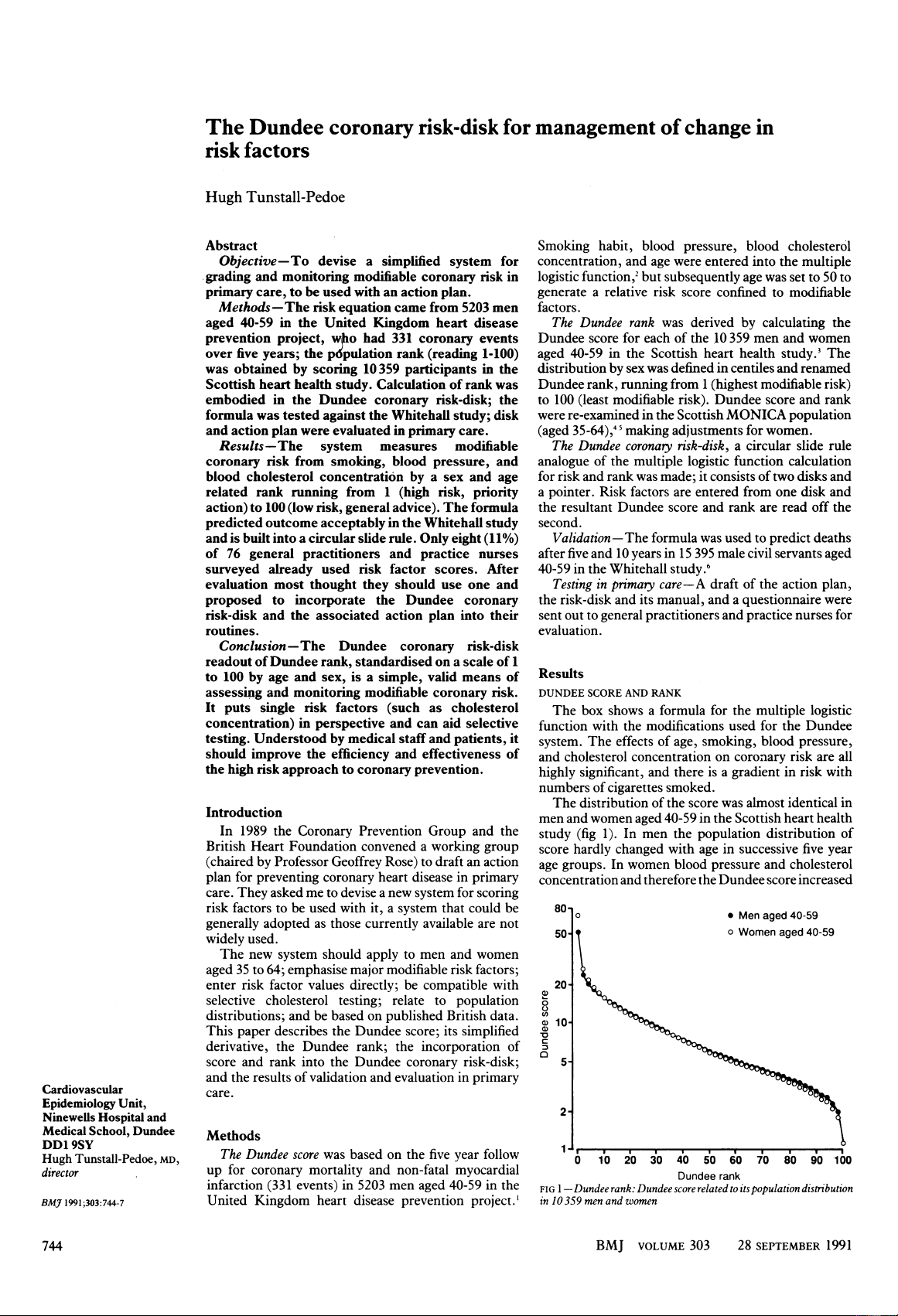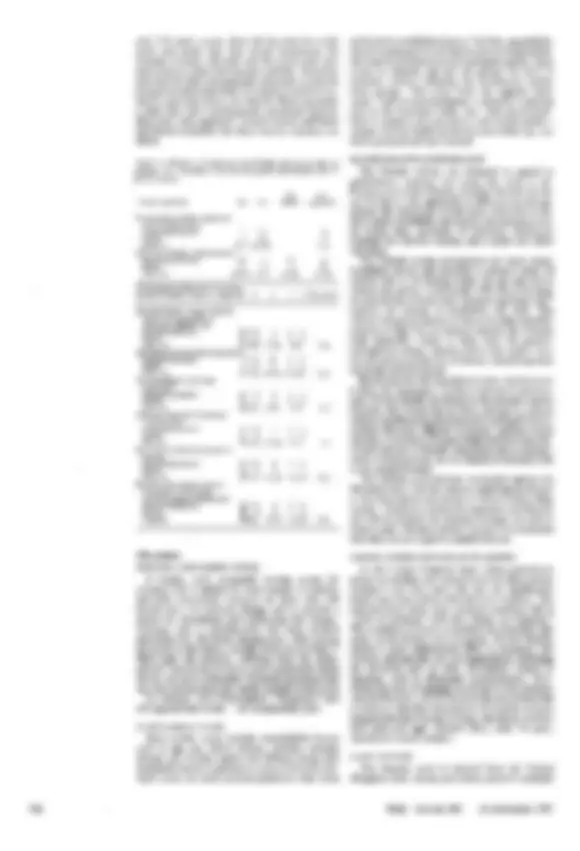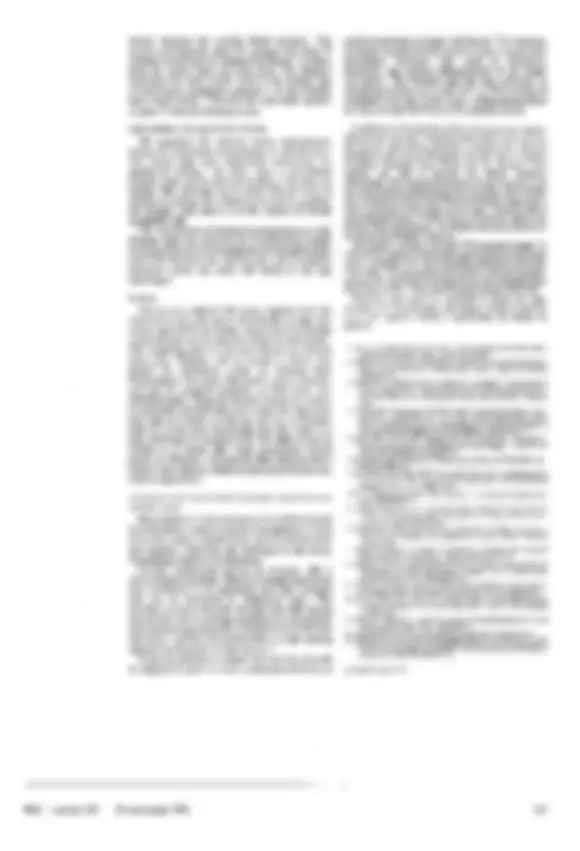




Study with the several resources on Docsity

Earn points by helping other students or get them with a premium plan


Prepare for your exams
Study with the several resources on Docsity

Earn points to download
Earn points by helping other students or get them with a premium plan
Community
Ask the community for help and clear up your study doubts
Discover the best universities in your country according to Docsity users
Free resources
Download our free guides on studying techniques, anxiety management strategies, and thesis advice from Docsity tutors
Abstract. Objective-To devise a simplified system for grading and monitoring modifiable coronary risk in primary care, to be used with an action plan.
Typology: Study notes
1 / 4

This page cannot be seen from the preview
Don't miss anything!



Abstract Objective-To devise a simplified system for grading and monitoring modifiable coronary risk in primary care, to be used with an action plan. Methods-The risk equation came from 5203 men aged 40-59 in the United Kingdom heart disease prevention project, wyho had 331 coronary events over five years; the p6pulation rank (reading 1-100) was obtained by scoring 10359 participants in the Scottish heart health study. Calculation of rank was embodied in the Dundee coronary risk-disk; the formula was tested against the Whitehall study; disk and action plan were evaluated in primary care. Results-The system measures modifiable coronary risk from smoking, blood pressure, and blood cholesterol concentration (^) by a (^) sex and age related rank running from (^1) (high risk, priority action) to 100 (low risk, general advice). The formula predicted outcome acceptably in the Whitehall study and is built into a circular slide rule. Only eight (11%) of 76 general practitioners and practice nurses surveyed already used risk factor scores. After evaluation most thought they should use one and proposed to incorporate the Dundee coronary risk-disk and the associated action plan into their routines. Conclusion-The Dundee coronary risk-disk readout of Dundee rank, standardised on a scale of 1 to 100 by age and sex, is a simple, valid means of assessing and monitoring modifiable coronary risk. It puts single risk factors (such as cholesterol concentration) in perspective and can aid selective testing. Understood by medical staff and patients, it should improve the efficiency and effectiveness of the high risk approach to coronary prevention.
Cardiovascular Epidemiology Unit,
Medical School, Dundee DD1 9SY Hugh Tunstall-Pedoe, MD, director
BM 1991;303:744-
Introduction
British Heart Foundation convened a (^) working group
plan for preventing (^) coronary heart disease in (^) primary care. They asked me to devise a new system for scoring
generally adopted as those currently available are not
The new system should apply to men and women
selective cholesterol testing; relate to population
score and rank into the Dundee coronary risk-disk;
care.
Methods The Dundee score (^) was based on the five year follow
infarction (^) (331 events) in 5203 men (^) aged 40-59 in the
Smoking habit, blood pressure, blood cholesterol concentration, and age were entered into the multiple logistic function,2 but subsequently age was set to 50 to generate a relative risk score confined to modifiable factors. The Dundee rank was derived by calculating the Dundee score for each of the 10 359 men and women aged 40-59 in the Scottish heart health study.3 The distribution by sex was defined in centiles and (^) renamed Dundee rank, running from 1 (highest modifiable risk)
(aged 35-64),4 making adjustments for women. The Dundee (^) coronary risk-disk, a circular slide rule analogue of the^ multiple logistic function calculation for risk and rank was made; it consists of two disks and a pointer. Risk factors are entered from one disk and the resultant Dundee score and rank are read off the second.
40-59 in the Whitehall study.
the risk-disk and its manual, and a questionnaire were sent out to general practitioners and practice nurses for evaluation.
Results DUNDEE SCORE AND RANK
function with the modifications used for the Dundee
and cholesterol concentration^ on^ coronary risk^ are^ all
numbers of (^) cigarettes smoked. The distribution of the score was almost identical in men and women aged 40-59 in the Scottish heart health
score hardly changed with age in successive five year age groups. In women blood pressure and cholesterol concentration and therefore the Dundee score increased
50- o^ Women^ aged 40-
20 0
a^ a10-
0 10 20 30 40 50 60 70 80 90 100 Dundee rank FIG 1-Dundee rank: Dundee score related to its population distribution in 10359 men and women
Multiple logistic function formula and modifications
Five (^) year risk (^) of coronary heart disease
l+e-(a + bix,^ + b2x2 + b3x3 + b4x4)
Coefficients (SEs) a = -10- (^117) (0-745) = constant*
b2 =^ 0-010543 (0^ 00270)^ x2^ =^ systolic^ blood^ pressure (mm Hg) b3 =^ 0-009378^ (0-00131)^ X3^ =^ cholesterol^ (mg/100 ml)** b4 =^1 00 X4= smoking^ code^ (see^ below)***
Smoking codes Never smoked =^ 0-0 (preset) Ex-smoker or pipe or cigar smoker =^ 0- 1453 (0-224) Cigarettes per day: 1-9 = 0-4483 (0-274) 20 10 = 0-9242 (0 283) 21- 11-19 = 1-019 (0 228) 330
Modificationsfor Dundee coronary risk-disk: *Constant "a" reset for fixed age 50: -10 117 + (50 x 0-0651) = -6-8624. This value is constant for men but is modified in women by age: 35 =^ +0-5719; 40 =^ +0 3875; 45 = +0- 1922; 50 =^ +0-0156; 55 =^ -0 1047; 60 =^ -0-2219; 65 =^ -^ 0-
**Cholesterol: b3= 0-3627; X3 =^ cholesterol (mmol/l)
***Cigarette dose-response rationalised to: 1-4/day = 0- 5-9/day =^ 0 406^ +^ (No of^ cigarettes -5)(0-08 13) 10-29/day = 0-8125 + (No of cigarettes - (^) 10) (0-0312) ¢30/day =^ 1-437.
= 1 263 (^) (0 303) = 1 431 (0 285)
rotations is therefore line (^) up the disks, rotate both
self evident.
to rank 15 would produce 15% of men in each five year age group 40-59, whereas in women it would produce 15% overall, but twice as many women aged 55-59 as
constant relation across age and sex groups. The
FIG 2-Front and rear views ofDundee coronary risk-disk
TABLE I-Deathsfrom coronary causes afterfive and l0years in 15 395 male civil servants aged 40-59 by decile ofDundee score
No (%) of deaths After 5 After 10 Decile of years years Dundeescore (n=195) (n=510)
1 8 (4) 18 (4) 2 10(5) 24 (5) 3 13 (7) 33 (6) 4 18 (9) 40 (8) 5 21 (11) 42 (8) (^6) 9(5) 37 (7) (^7 16) (8) 52 (10) (^8 21) (11) 56(11) (^9 29) (15) 84(16) (^10) 50(26) 124 (24)
DUNDEE CORONARY RISK-DISK
made and field tested as concentric card (^) disks. The
is warranted. The rear disk contains concentric scales
normal (^) or Gaussian distribution curve on the score
USE OF THE DISK
VALIDATION Applied to the Whitehall study, the Dundee score produced the risk gradient shown in table I, placing in the top 20% of risk 41% of the 195 deaths from coronary heart disease after five years and 40% of the (^510) deaths after 10 years. The relative risk of those in the top versus bottom decile ofrisk was 6 3 in five years and 6 9 in 10 years.
TESTING IN PRIMARY CARE General (^) practitioners (and their (^) nurses) were recruited from a (^) cardiology course in Newcastle and (^) practice nurses (^) (and their (^) doctors) from (^) their conference in Perth. The (^) response from Newcastle produced 33 forms from (^) practitioners and 12 from nurses; that from Perth (^) produced 11 forms from doctors and 20 from nurses. After (^) inability to (^) partici- pate was corrected for the response rate (^) among Newcastle doctors was (^) 85%; the (^) response from Perth was less complete. Results were similar and were
out risk factor assessment or were about to do so, but
logistic function for systolic blood pressure. The project used diastolic phase IV readings, but phase V
from the project have not been used. The diastolic equivalent for each systolic value is the reading that
heart health study.3 The risk-disk uses either systolic or phase V diastolic blood pressure.
CHOLESTEROL AND SELECTIVE TESTING
The argument for selective versus opportunistic
The action plan lists unifactorial indications for
Dundee rank can be derived pending a decision on testing. The risk-disk can be used with any level of cholesterol testing. If a cholesterol result is available the Dundee rank places it in the context of overall modifiable risk. The contribution of cholesterol measurement to the Dundee rank was tested in the Scottish heart health study population by correlating the provisional Dundee rank with^ the final one. Seventy per cent of subjects remained (^) within the same risk decile or the one
WOMEN The use of a relative risk score, (^) together with the observation that risk factor distributions in men and
score and rank can be used for women as well as men.
from men. Absolute risk in women is lower, but
is reasonable provided that users remember that score and rank are relative to that age and sex-a Dundee rank of 5 is far more threatening over five years to a man of 60 than to a woman of 40. The offset by age in
preset cut off points. Altering the offset does not affect relative risk relations within an age group because the
POTENTIAL FOR THE DUNDEE (^) CORONARY RISK-DISK AND DUNDEE RANK Measurement ofrisk is not an end in (^) itself but (^) should
those who stand to benefit most, and to motivate staff
Current commercial interest in coronary risk is
risk can be (^) expressed in cholesterol units. The
It may be ambitious to expect that the risk-disk will
practices assessing coronary risk factors. The adoption ofa single standard would, however, have considerable advantages. Coronary risk could be discussed, measured, and tracked independently of any single risk factor. The Dundee rank has that potential: in classifying patients on a scale of 1 to 100 in terms of modifiable risk and, in lay terms, telling patients how far (^) they are from the (^) front of the coronary queue.
In addition to the members of the working (^) group respons- ible for the action plan, I thank for help, ideas, and criticisms the doctors and nurses involved in formal and informal evaluations; Dr Simon Thompson and Mr Martin (^) Shipley (London); Professor Gino Farchi and Dr Susanna Conti (Rome); the staff of Gerrard and Medd, designers (Edinburgh); the Coronary Prevention Group (London); and the cardiovascular epidemiology unit (Dundee). The Dundee unit is funded by the Scottish Home and Health Department; views expressed in this paper are my own. Financial help is acknowledged from a Toshiba Year of Invention award, the British Heart lioundation, the Health Education Board for Scotland, and Dundee University. The Dundee coronary risk-disk (UK registered design No 2 011 353) is supplied with an illustrated manual at a unit price ofF 15 (including VAT) plus £3 handling charge for each order (1-49 disks). An educational videocassette, software program, full price list, and further information are also available from: Risk-Disk, CVEU, Ninewells Hospital, Dundee DD1 9SY. Potential users must be prepared to spend the time necessary for familiarisation and simple testing to prevent error; the^ suppliers disclaim responsibility for misuse in practice.
1 Rose G, Tunstall-Pedeo H, Heller RF. UK heart disease prevention project: incidence and mortality results. Lancet 1983;i: 1062-5. 2 Chambless LE, Dobson A, Patterson CC, Raines B. On the use ofa logistic risk score in predicting risk of coronary heart disease. Statistics in Medicine 1990;9:385-96. 3 Smith WCS, Tunstall-Pedoe H, Crombie IK, Tavendale R. Concomitants of excess coronary deaths-major risk factor and lifestyle findings from 10 359 men and women in the Scottish heart health study. Scot Med J 1989;34: 550-5. 4 World Health Organisation MONICA Project Principal Investigators (Pre- pared by Tunstall-Pedoe H). The World Health Organization Monica Project (Monitoring trends and determinants in cardiovascular disease): a major international collaboration. J^ Clin Epidemiol 1988;41:105-14. 5 Smith WCS, Shewry MC, Tunstall-Pedoe H, Crombie IK, Tavendale R. Cardiovascular disease in Edinburgh and north Glasgow-a tale of two cities. J Clin Epidemiol 1990;43:637-43. 6 Jarrett RJ, Shipley MJ, Rose G. Weight and mortality in the Whitehall study. BMJ7 1982;285:535-7. 7 Tunstall-Pedoe H, Smith WCS, Tavendale R. How-often-that-high graphs of serum cholesterol. Findings from the Scottish heart health and Scottish MONICA studies. Lancet 1989;i:540-2. 8 British Hypertension Society Working Party. Treating mild hypertension. BMJ (^) 1989;298:694-9. (^9) European Atherosclerosis (^) Society Study Group. Strategies for the prevention of coronary heart disease: a (^) policy statement of the (^) European Atherosclerosis Society. EurHeartJ^ 1987;8:77-88. 10 Thorsen RD, Jacobs (^) DR, Grimm RH. Preventive (^) cardiology in (^) practice: a device for risk estimation and (^) counselling in (^) coronary disease. (^) Prev Med 1979;8:548-56. 11 Shaper AG, Pocock (^) SJ, Phillips AN, Walker M. A (^) scoring system to (^) identify men at high risk of a heart attack. Health Trends 1987;19:37-9. 12 Heller RF, Chinn S, Tunstall-Pedoe (^) HD, Rose G. How well can we (^) predict the development of coronary heart disease? Findings in the UK heart disease prevention project. BMJ 1984;288:1409-11. 13 Coronary Prevention Group and British Heart Foundation. Action (^) plan for preventing coronary heart disease in primary care. BMJ 1991;303:748-50. 14 Lee AJ, Smith WCS, Lowe GDO, Tunstall-Pedoe H. Plasma fibrinogen and coronary risk factors: the Scottish heart health study. 7 Clin Epidemiwl 1990;43:913-9. 15 Petrie JG, O'Brien ET, Littler WA, de Swiet M. Recommendations on blood pressure measurement. BMJ 1986;293:611-5. 16 Tunstall-Pedoe H. Who is for cholesterol testing? BMJ 1989;298:1593-4. 17 Imperial Cancer Research Fund OXCHECK Study Group. Prevalence of risk factors for heart disease in OXCHECK trial: implications for screening in primary care. BMJ 1991;302:1057-60. (Accepted 20 August (^) 1991)